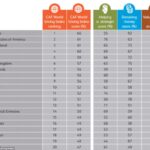If workplace giving seems to increase every year, that’s because it does! While the US economy may have taken a beating in the past 5 years, studies show that employees are just as likely to give as ever, especially as the economy recovers and begins to grow in new and different ways.
Just how much? Charity Navigator research pegged total giving to charitable organizations at $358.38 billion in 2014 (about 2% of GDP). This is an increase of 7.1% from 2013. In fact, last year was the first to surpass the previous high-water mark of $355.17 billion seen in 2007. Experts anticipate this year to be even bigger in corporate giving.
And while corporate giving may not sound like the most sentimental of acts, there’s no denying that when companies empower their employees to give and support that giving with efforts at the executive level, amazing things happen. Nearly $18 billion was contributed by corporations last year, an increase of 13.7%.
Individual charitable donations account for between 75-90% of all gifts, which means, simply, your employees WANT to give. In fact, they are already giving to organizations that support education, the local community and causes that are meaningful for them. Corporate philanthropy can not only support this, but provide a way to increase engagement, creating recruitment opportunities and building a coveted employer brand of the future.
Matched Giving Programs
Matched Giving or Matching Gifts as they are commonly called, is exactly what it sounds like. Encouraging your employees to give to a cause and then matching their gift with corporate money, up to a certain limit. Running a matching gift program is inherently easy and can be a key first step in setting up any corporate philanthropy efforts. According to Double the Donation, about 65% of Fortune 500 companies match employee donations. The number climbs even higher when looking at midsize companies. In order to start an employee matching program, create as broad a selection of charities as possible for your employees to choose from. Include both local (vetted) charities as well as giving opportunities on a larger scale. Employees are likely to follow the trends of consumers in “free choice options.” According to Plan G, 80% of consumers gave to charities of their own choice as opposed to those endorsed by a brand – and 96% gave to a local organization over a national organization.
To note: Compliance is made simple by robust software platforms that can automatically vet charities based on your programs rules and guidelines and adherence to stringent global laws, allowing you to run a well-defined employee matching program or a complete corporate philanthropy program.
The Gift of Time
While monetary gifts are definitely needed to support charities, sometimes the greatest gift you can give is time. Your workplace is full of highly skilled people who could give their time and talent to a charity that desperately needs it. From creating a business plan, to rock solid accounting skills, to designing a website, consider implementing a program that allows your employees to quite literally pitch in. This is called skills-based volunteering! Studies showskills-based volunteering can be seen as a solution for employees’ preference of short-term volunteer opportunities and being involved in developing volunteer opportunities. While volunteering may conjure up stereotypes of serving up mashed potatoes at a local soup kitchen or building a house (both noble and worthy causes), your team can also offer up skills they’ve honed within your walls.


































































































































